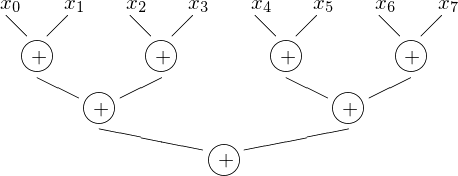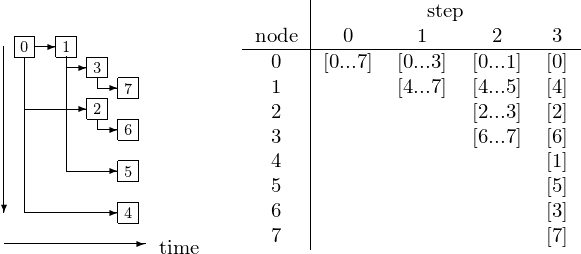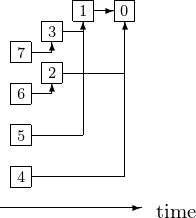Data Partitioning¶
To distribute the work load, we distinguish between functional and domain decomposition. To synchronize computations, we can use MPI_Barrier. We consider efficient scatter and gather implementations to fan out data and to fan in results. To overlap the communication with computation, we can use the nonblocking immediate send and receive operations.
functional and domain decomposition¶
To turn a sequential algorithm into a parallel one, we distinguish between functional and domain decomposition: In a functional decomposition, the arithmetical operations are distributed among several processors. The Monte Carlo simulations are example of a functional decomposition. In a domain decomposition, the data are distributed among several processors. The Mandelbrot set computation is an example of a domain decomposition. When solving problems, the entire data set is often too large to fit into the memory of one computer. Complete game trees (e.g.: the game of connect-4 or four in a row) consume an exponential amount of memory.
Divide and conquer used to solve problems:
break the problem in smaller parts;
solve the smaller parts; and
assemble the partial solutions.
Often, divide and conquer is applied in a recursive setting where the smallest nontrivial problem is the base case. Sorting algorithms which apply divide and conquer are mergesort and quicksort.
parallel summation¶
Applying divide and conquer, we sum a sequence of numbers with divide and conquer, as in the following formula.
The grouping of the summands in pairs is shown in Fig. 24.

Fig. 24 With 4 processors, the summation of 8 numbers in done in 3 steps.¶
The size of the problem is n, where \(\displaystyle S = \sum_{k=0}^{n-1} x_k\). Assume we have 8 processors to make 8 partial sums:
where \(m = (n-1)/8\) and \(\displaystyle S_i = \sum_{k=0}^{m} x_{k + im}\) The communication pattern goes along divide and conquer:
the numbers \(x_k\) are scattered in a fan out fashion,
summing the partial sums happens in a fan in mode.
Fanning out an array of data is shown in Fig. 25.

Fig. 25 Fanning out data.¶
Algorithm: at step k, 2**k processors have data, and execute:
for j from 0 to 2**(k-1) do
processor j sends data/2**(k+1) to processor j + 2**k;
processor j+2**k receives data/2**(k+1) from processor j.
In fanning out, we use the same array for all nodes, and use only one send/recv statement. Observe the bit patterns in nodes and data locations, as shown in Table 9.
step |
|||||
|---|---|---|---|---|---|
node |
0 |
1 |
2 |
3 |
data |
000 |
[0…7] |
[0…3] |
[0…1] |
[0] |
000 |
001 |
[4…7] |
[4…5] |
[4] |
100 |
|
010 |
[2…3] |
[2] |
010 |
||
011 |
[6…7] |
[6] |
110 |
||
100 |
[1] |
001 |
|||
101 |
[5] |
101 |
|||
110 |
[3] |
011 |
|||
111 |
[7] |
111 |
|||
At step 3, the node with label in binary expansion \(b_2 b_1 b_0\) has data starting at index \(b_0 b_1 b_2\).
Fanning out with MPI is illustrated below, with 8 processes.
$ mpirun -np 8 /tmp/fan_out_integers
stage 0, d = 1 :
0 sends 40 integers to 1 at 40, start 40
1 received 40 integers from 0 at 40, start 40
stage 1, d = 2 :
0 sends 20 integers to 2 at 20, start 20
2 received 20 integers from 0 at 20, start 20
1 sends 20 integers to 3 at 60, start 60
3 received 20 integers from 1 at 60, start 60
stage 2, d = 4 :
0 sends 10 integers to 4 at 10, start 10
7 received 10 integers from 3 at 70, start 70
3 sends 10 integers to 7 at 70, start 70
4 received 10 integers from 0 at 10, start 10
1 sends 10 integers to 5 at 50, start 50
2 sends 10 integers to 6 at 30, start 30
6 received 10 integers from 2 at 30, start 30
5 received 10 integers from 1 at 50, start 50
data at all nodes :
1 has 10 integers starting at 40 with 40, 41, 42
2 has 10 integers starting at 20 with 20, 21, 22
7 has 10 integers starting at 70 with 70, 71, 72
5 has 10 integers starting at 50 with 50, 51, 52
0 has 10 integers starting at 0 with 0, 1, 2
6 has 10 integers starting at 30 with 30, 31, 32
3 has 10 integers starting at 60 with 60, 61, 62
4 has 10 integers starting at 10 with 10, 11, 12
To synchronize across all members of a group we apply MPI_Barrier(comm)
where comm is the communicator (MPI_COMM_WORLD).
MPI_Barrier blocks the caller until all group members
have called the statement.
The call returns at any process only after all group members
have entered the call.
The synchronization in each stage of the fan out must be done because the processors with high identification numbers may only start sending the data in later stages, when they have received the data from processors with low identification numbers.
The computation of the offset is done by the function parity_offset,
as used in the program to fan out integers.
int parity_offset ( int n, int s );
/* returns the offset of node with label n
* for data of size s based on parity of n */
int parity_offset ( int n, int s )
{
int offset = 0;
s = s/2;
while(n > 0)
{
int d = n % 2;
if(d > 0) offset += s;
n = n/2;
s = s/2;
}
return offset;
}
The main program to fan out integers is below.
int main ( int argc, char *argv[] )
{
int myid,p,s,i,j,d,b;
int A[size];
MPI_Status status;
MPI_Init(&argc,&argv);
MPI_Comm_size(MPI_COMM_WORLD,&p);
MPI_Comm_rank(MPI_COMM_WORLD,&myid);
if(myid == 0) /* manager initializes */
for(i=0; i<size; i++) A[i] = i;
s = size;
for(i=0,d=1; i<3; i++,d*=2) /* A is fanned out */
{
s = s/2;
if(v>0) MPI_Barrier(MPI_COMM_WORLD);
if(myid == 0) if(v > 0) printf("stage %d, d = %d :\n",i,d);
if(v>0) MPI_Barrier(MPI_COMM_WORLD);
for(j=0; j<d; j++)
{
b = parity_offset(myid,size);
if(myid == j)
{
if(v>0) printf("%d sends %d integers to %d at %d, start %d\n",
j,s,j+d,b+s,A[b+s]);
MPI_Send(&A[b+s],s,MPI_INT,j+d,tag,MPI_COMM_WORLD);
}
else if(myid == j+d)
{
MPI_Recv(&A[b],s,MPI_INT,j,tag,MPI_COMM_WORLD,&status);
if(v>0)
printf("%d received %d integers from %d at %d, start %d\n",
j+d,s,j,b,A[b]);
}
}
}
if(v > 0) MPI_Barrier(MPI_COMM_WORLD);
if(v > 0) if(myid == 0) printf("data at all nodes :\n");
if(v > 0) MPI_Barrier(MPI_COMM_WORLD);
printf("%d has %d integers starting at %d with %d, %d, %d\n",
myid,size/p,b,A[b],A[b+1],A[b+2]);
MPI_Finalize();
return 0;
}
The same program in Python uses mpi4py and numpy.
As the program fans out an array of 80 integers over 8 processors,
it must be executed as
mpiexec -n 8 python3 fan_out_integers.py
The print statements in verbose mode are omitted in the code below.
import numpy as np
from mpi4py import MPI
COMM = MPI.COMM_WORLD
SIZE = 80 # size of the problem
def parity_offset(n, s):
"""
Returns the offset of node with label n
for data of size s based on parity of n.
"""
offset = 0
dim = n
wsz = s//2
while dim > 0:
d = dim % 2
if d > 0:
offset += wsz
dim = dim//2
wsz = wsz//2
return offset
def main(verbose=True):
"""
Fans out 80 integers to 8 processors.
"""
myid = COMM.Get_rank()
p = COMM.Get_size()
# manager initializes, workers allocate space
if myid == 0:
data = np.arange(SIZE, dtype='i')
else:
data = np.empty(SIZE, dtype='i')
# the code below has no verbose statements
d = 1 # depth
s = SIZE # size of a slice
b = 0 # begin index
for i in range(3): # in 3 steps for 8 nodes
s = s//2
for j in range(d):
b = parity_offset(myid, SIZE);
if myid == j:
slice = data[b+s: b+2*s]
COMM.Send([slice, MPI.INT], dest=j+d)
elif myid == j+d:
slice = data[b: b+s]
COMM.Recv([slice, MPI.INT], source=j)
d = 2*d
The version in Julia with mpi.jl is listed next.
To synchronize the printing in verbose mode, MPI_Barrier is applied.
using MPI
MPI.Init()
COMM = MPI.COMM_WORLD
# size of the problem
SIZE = 80
"""
function parity_offset(n::Int, s::Int)
returns the offset of node with label n
for data of size s based on parity of n.
"""
function parity_offset(n::Int, s::Int)
offset = 0
dim = n
wsz = div(s, 2)
while dim > 0
d = dim % 2
if d > 0
offset += wsz
end
dim = div(dim, 2)
wsz = div(wsz, 2)
end
return offset
end
"""
function main(verbose=True)
fans out 80 integers to 8 processors.
"""
function main(verbose::Bool=true)
myid = MPI.Comm_rank(COMM)
p = MPI.Comm_size(COMM)
# manager initializes, workers allocate space
if myid == 0
data = [i for i=1:SIZE]
else
data = zeros(SIZE)
end
d = 1
s = SIZE
b = 0
for i=0:2
s = div(s, 2)
if verbose
MPI.Barrier(COMM)
if myid == 0
println("stage ", i, " d = ", d)
end
MPI.Barrier(COMM)
end
for j=0:d-1
b = parity_offset(myid, SIZE) + 1
if myid == j
if verbose
MPI.Barrier(COMM)
println(j, " sends ", s, " integers to ", j+d,
" at ", b+s, " start ", data[b+s],
" to ", data[b+2*s-1])
MPI.Barrier(COMM)
end
slice = data[b+s: b+2*s]
MPI.send(slice, COMM; dest=j+d, tag=11)
elseif myid == j+d
data[b: b+s] = MPI.recv(COMM; source=j, tag=11)
if verbose
MPI.Barrier(COMM)
println(j+d, " received ", s, " integers from ", j,
" at ", b, " start ", data[b],
" to ", data[b+s-1])
MPI.Barrier(COMM)
end
end
end
d = 2*d
end
if verbose
MPI.Barrier(COMM)
println(myid, " has ", div(SIZE, p), " integers starting at ", b,
" with ", data[b], data[b+1], " to ", data[b+div(SIZE, p)-1])
MPI.Barrier(COMM)
end
end
main()
To execute the above program, saved as fan_out_integers.jl, do
mpiexecjl -n 8 julia fan_out_integers.jl
Fanning in the results is illustrated in Fig. 26.

Fig. 26 Fanning in results.¶
Algorithm: at step k, 2**k processors send results and execute:
for j from 0 to 2**k-1 do
processor j+2**k sends the result to processor j;
processor j receives the result from processor j+2**k.
We run the algorithm for decreasing values of k: for example: k=2,1,0.
An Application¶
Computing \(\pi\) to trillions of digits is a benchmark problem for supercomputers.
One of the remarkable discoveries made by the PSLQ Algorithm (PSLQ = Partial Sum of Least Squares, or integer relation detection) is a simple formula that allows to calculating any binary digit of \(\pi\) without calculating the digits preceding it:
BBP stands for Bailey, Borwein and Plouffe. Instead of adding numbers, we concatenate strings.
Some readings on calculations for $pi$ are listed below:
David H. Bailey, Peter B. Borwein and Simon Plouffe: On the Rapid Computation of Various Polylogarithmic Constants. Mathematics of Computation 66(218): 903–913, 1997.
David H. Bailey: the BBP Algorithm for Pi. September 17, 2006. <http://crd-legacy.lbl.gov/~dhbailey/dhbpapers/>
Daisuke Takahashi: Parallel implementation of multiple-precision arithmetic and 2, 576, 980, 370, 000 decimal digits of pi calculation. Parallel Computing 36(8): 439-448, 2010.
Nonblocking Point-to-Point Communication¶
The MPI_SEND and MPI_RECV are blocking:
The sender must wait till the message is received.
The receiver must wait till the message is sent.
For synchronized computations, this is desirable. To overlap the communication with the computation, we may prefer the use of nonblocking communication operations:
MPI_ISENDfor the Immediate send; andMPI_IRECVfor the Immediate receive.
The status of the immediate send/receive
can be queried with
MPI_TEST; orwe can wait for its completion with
MPI_WAIT.
The specification of the MPI_ISEND command
MPI_ISEND(buf, count, datatype, dest, tag, comm, request)
is in Table 10.
parameter |
description |
|---|---|
buf |
address of the send buffer |
count |
number of elements in send buffer |
datatype |
datatype of each send buffer element |
dest |
rank of the destination |
tag |
message tag |
comm |
communicator |
request |
communication request (output) |
The sender should not modify any part of the send buffer after a nonblocking send operation is called, until the send completes.
The specification of the MPI_IRECV command
MPI_IRECV(buf, count, datatype, source, tag, comm, request)
is in Table 11.
parameter |
description |
|---|---|
buf |
address of the receive buffer |
count |
number of elements in receive buffer |
datatype |
datatype of each receive buffer element |
source |
rank of source or |
tag |
message tag or |
comm |
communicator |
request |
communication request (output) |
The receiver should not access any part of the receive buffer after a nonblocking receive operation is called, until the receive completes.
After the call to MPI_ISEND or MPI_IRECV,
the request can be used to query
the status of the communication or wait for its completion.
To wait for the completion of a nonblocking communication:
MPI_WAIT (request, status)
with specifications in Table 12.
parameter |
description |
|---|---|
request |
communication request |
status |
status object |
To test the status of the communication:
MPI_TEST (request, flag, status)
with specifications in Table 13.
parameter |
description |
|---|---|
request |
communication request |
flag |
true if operation completed |
status |
status object |
Exercises¶
Adjust the fanning out of the array of integers so it works for any number \(p\) of processors where \(p = 2^k\) for some \(k\). You may take the size of the array as an integer multiple of \(p\). To illustrate your program, provide screen shots for \(p = 8, 16\), and 32.
Run the program of the previous exercise on the supercomputer, for \(p = 8, 16, 32, 64\), and 128.
For each run, report the wall clock time.
Complete the summation and the fanning in of the partial sums, extending the program. You may leave \(p = 8\).